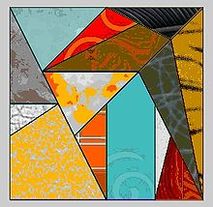Archimedes Palimpsest

Stomachion is a dissection puzzle in theArchimedes Palimpsest.
The foremost document containing the work of Archimedes is the Archimedes Palimpsest. In 1906, the Danish professor Johan Ludvig Heiberg visited Constantinople and examined a 174-page goatskin parchment of prayers written in the 13th century AD. He discovered that it was a palimpsest, a document with text that had been written over an erased older work. Palimpsests were created by scraping the ink from existing works and reusing them, which was a common practice in the Middle Ages as vellum was expensive. The older works in the palimpsest were identified by scholars as 10th century AD copies of previously unknown treatises by Archimedes. The parchment spent hundreds of years in a monastery library in Constantinople before being sold to a private collector in the 1920s. On October 29, 1998 it was sold at auction to an anonymous buyer for $2 million at Christie's in New York. The only known source of The Method of Mechanical Theorems, referred to by Suidas and thought to have been lost forever.Stomachion was also discovered in the palimpsest, with a more complete analysis of the puzzle than had been found in previous texts. The palimpsest is now stored at the Walters Art Museum in Baltimore, Maryland, where it has been subjected to a range of modern tests including the use of ultraviolet and x-ray light to read the overwritten text.
The treatises in the Archimedes Palimpsest are: On the Equilibrium of Planes, On Spirals, Measurement of a Circle, On the Sphere and the Cylinder, On Floating Bodies, The Method of Mechanical Theorems and Stomachion.
The foremost document containing the work of Archimedes is the Archimedes Palimpsest. In 1906, the Danish professor Johan Ludvig Heiberg visited Constantinople and examined a 174-page goatskin parchment of prayers written in the 13th century AD. He discovered that it was a palimpsest, a document with text that had been written over an erased older work. Palimpsests were created by scraping the ink from existing works and reusing them, which was a common practice in the Middle Ages as vellum was expensive. The older works in the palimpsest were identified by scholars as 10th century AD copies of previously unknown treatises by Archimedes. The parchment spent hundreds of years in a monastery library in Constantinople before being sold to a private collector in the 1920s. On October 29, 1998 it was sold at auction to an anonymous buyer for $2 million at Christie's in New York. The only known source of The Method of Mechanical Theorems, referred to by Suidas and thought to have been lost forever.Stomachion was also discovered in the palimpsest, with a more complete analysis of the puzzle than had been found in previous texts. The palimpsest is now stored at the Walters Art Museum in Baltimore, Maryland, where it has been subjected to a range of modern tests including the use of ultraviolet and x-ray light to read the overwritten text.
The treatises in the Archimedes Palimpsest are: On the Equilibrium of Planes, On Spirals, Measurement of a Circle, On the Sphere and the Cylinder, On Floating Bodies, The Method of Mechanical Theorems and Stomachion.
